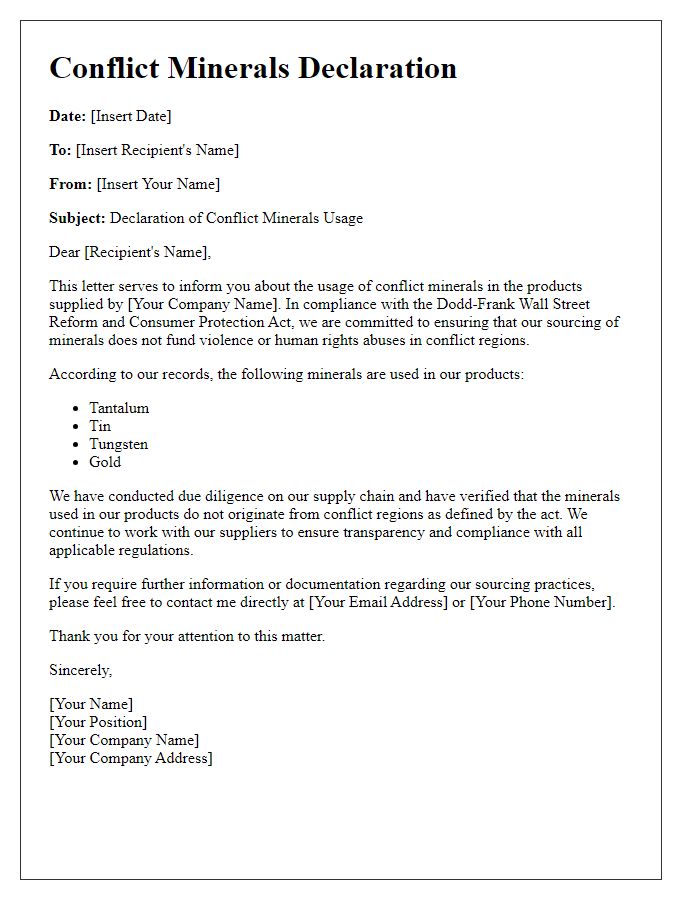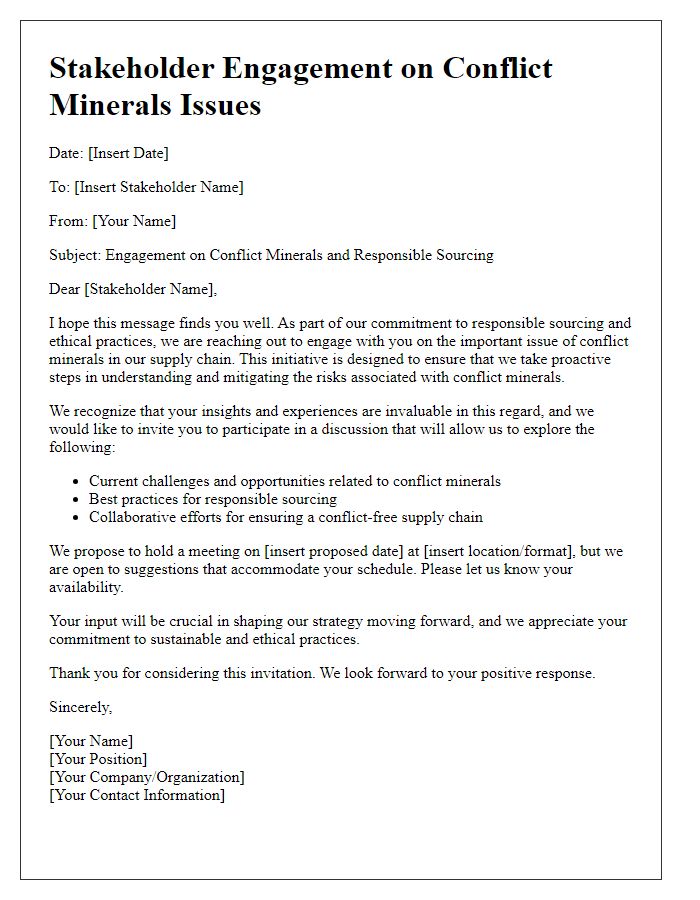Are you navigating the intricate world of conflict minerals disclosure? It's crucial for companies to understand their obligations and the ethical implications of sourcing practices. In light of increasing consumer awareness and regulatory pressures, having a clear and transparent letter template can help articulate your commitment to responsible sourcing. Join us as we explore essential elements and best practices in crafting your conflict minerals disclosure letter!

Compliance with SEC regulations
Conflict minerals disclosure is essential for companies under SEC regulations, particularly those that utilize tantalum, tin, tungsten, and gold in their products. The Dodd-Frank Wall Street Reform and Consumer Protection Act (introduced in 2010) mandates sourcing information regarding the origin of these minerals from conflict-affected regions, notably the Democratic Republic of the Congo (DRC). Transparency measures aim to mitigate the financing of armed groups exploiting these minerals, thereby promoting ethical sourcing practices. Corporations must conduct due diligence by tracing mineral supply chains, engaging with suppliers, and compiling detailed reports outlining sourcing practices. Compliance with SEC Form SD (specialized disclosure) requires annual filings that disclose whether the minerals originated from the DRC or surrounding countries, providing a clear commitment to responsible investment and supply chain management.
Supply chain due diligence
Conflict minerals, including tin, tantalum, tungsten, and gold, are often sourced from regions affected by violence, particularly the Democratic Republic of the Congo (DRC). Companies engaging in supply chain due diligence must identify and assess the origin of these minerals to ensure responsible sourcing. Each year, firms are mandated to report efforts in preventing the financing of armed groups (as outlined in the Dodd-Frank Wall Street Reform and Consumer Protection Act). Comprehensive audits and supplier assessments, alongside engagement with industry initiatives and certification programs, facilitate transparency. Additionally, traceability systems and partnerships with reputable organizations can ensure compliance with ethical sourcing standards, ultimately aiding in the reduction of human rights abuses linked to mineral extraction.
Conflict minerals reporting template
Conflict minerals disclosure is essential for companies to address and report on the sourcing of materials such as tin (cassiterite), tungsten (wolframite), tantalum (coltan), and gold that may originate from regions experiencing armed conflict, particularly the Democratic Republic of the Congo (DRC) and surrounding countries. The goal is to ensure that these minerals are not contributing to human rights violations or environmental degradation. Accurate reporting involves gathering information from suppliers regarding the mineral sources, supply chain practices, and due diligence measures in place. Compliance with regulations such as the Dodd-Frank Act requires detailed documentation that helps stakeholders understand the ethical implications of the sourcing practices. This increased transparency fosters accountability while promoting responsible sourcing and helps mitigate reputational risks associated with conflict minerals.
Efforts to identify source countries
In response to increasing global awareness regarding conflict minerals, many companies engage in comprehensive efforts to identify source countries of minerals such as tantalum, tin, tungsten, and gold. This includes conducting supply chain due diligence as outlined by the OECD Due Diligence Guidance for Responsible Supply Chains. Companies implement strategies such as mapping the supply chain, engaging with suppliers to obtain supplier declarations, and utilizing third-party audits to verify sourcing claims. Geographic regions of concern, primarily the Democratic Republic of the Congo (DRC) and surrounding countries, demand particular attention due to historical associations with armed groups and human rights violations. Additionally, organizations like the Responsible Minerals Initiative assist companies in promoting responsible sourcing practices, emphasizing transparency and ethical responsibility in mineral procurement. By prioritizing these efforts, companies aim to minimize the risk of contributing to conflict and promote sustainable development in affected regions.
Responsible sourcing practices
Conflict minerals disclosure emphasizes responsible sourcing practices in alignment with regulations such as the Dodd-Frank Act. Companies must identify minerals like tantalum, tin, tungsten, and gold, primarily sourced from regions like the Democratic Republic of Congo (DRC). These minerals often fund armed groups, contributing to human rights abuses. Supply chains require thorough tracing to ensure that materials do not originate from conflict-affected areas. Auditing suppliers becomes essential to verify compliance with ethical standards and corporate social responsibility (CSR) initiatives. Transparency in reporting not only mitigates legal risks but also enhances brand reputation among consumers who prioritize ethical sourcing.













Comments